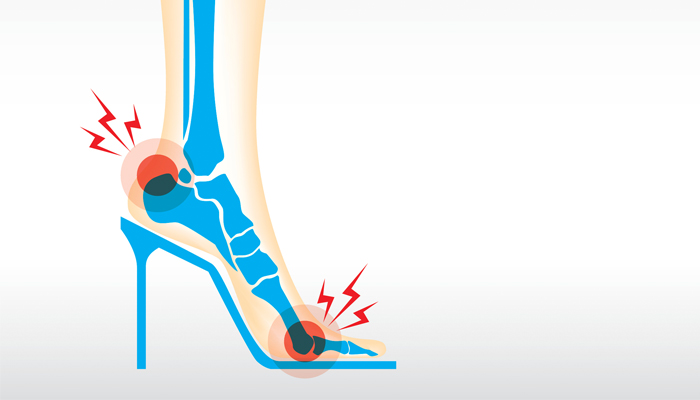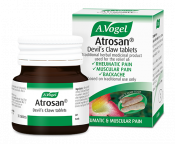How can shoes cause back pain?
Although the feet may seem quite a distance away from the back, they can influence back pain. This is down to various factors, such as the way we move our feet when walking, as well as the type of shoe we wear and how much support they offer.
To better understand why shoes could be responsible for your back pain, this blog will cover:
- Weight loss/toning shoes and back pain
- Heels and back pain
- Flat shoes and back pain
- Flip flops and back pain
- How to relieve back pain caused by shoes.
Weight loss/toning shoes and back pain
Paying attention to your footwear can help to prevent back pain caused by shoes, but which shoes are the main culprits of back pain in the first place?
First on our list is perhaps the most problematic and the least known about: figure-fixing shoes.
Toning shoes are designed with little mini pods on the soles that are similar to wobble boards. These mimic walking on an unstable surface and the aim of this is to make you work muscles in the legs that wouldn't normally be used when walking. However, the unusual sole of this shoe results in the abnormal distribution of body weight which, in turn, can lead to strain in the Achilles tendons, as well as injuries in the ankle, knee and back.
Toning shoes may also have a curved sole, which is again designed to make you use extra leg muscles when walking. These can also cause a change to walking posture, thus resulting in back pain. Without a flat sole on the shoe, there is also an increased likelihood of falls.
How to prevent the damage:
|
Heels and back pain
The Spine Health Institute has found that around 72% of women wear high heels.1 However, unfortunately, high heels are an extremely common cause of back pain.
Whilst you may enjoy the opportunity to pick out a new pair, any heel with an angle greater than an inch can cause countless problems in the body. High heels not only affect the spine, they negatively impact the feet, knees, and hips too!
This is because wearing high heels shifts the bodyweight forward onto the balls of the feet, adding pressure to the bones and joints. Heels also restrict the range of motion in the foot and can lead to foot problems such as bunions, ingrown toenails, and hammertoe deformities.

Wearing heels regularly may also shorten and tighten the calf muscles, making it difficult to extend the leg and causing the quadriceps to work overtime. This puts a phenomenal amount of stress on the knee joints and can pull the kneecaps out of alignment too!
And the kneecaps aren't the only joints that are forced out of alignment from wearing those pesky heels! The hips have a fundamental role in any leg movement (running, walking etc.) so pushing them out of alignment by wearing heels can cause pain in associated leg muscles, such as the adductors (inner thigh muscles), hamstrings, and glutes (butt muscles).
On top of this, wearing high heels pushes your chest and pelvis forward and this unnatural posture further contributes to pain in the lower spine.
Wearing heels continuously can cause chronic back soreness, spasms and can even lead to arthritis. So how do you prevent this damage from happening to your body? Well, the obvious solution is don't wear them! However, if you don't feel like ditching the heels, why not take preventative measures to protect your body?
How to prevent the damage:
|
Flat shoes and back pain
By this point, I may have convinced you that flat shoes are the way to go! However, don't rush out to buy a new pair just yet. Flat shoes are next on my list of shoes that could be causing your back pain.
Completely flat shoes do not provide any support for your feet, which then has a knock-on effect on the rest of the body - similar to what we have observed in wearing heels.

Flat shoes can cause tight Achilles tendons, as well as putting strain on the Plantar Fascia which helps to support the arches of the feet. This tightness can then result in fallen arches (or flat feet) which is when the foot lies completely flat and pressed against the ground. If this is left untreated, over time it can lead to osteoarthritis of the knee joints.
On top of all this, flat shoes may cause overstretching or tearing of the tendons and ligaments in the feet, plus they put added pressure on the heel of the foot. This is because there is little or no shock absorption from the shoe itself, so instead the impact from movements like walking are taken on by the feet.
Another issue to bear in mind is that flat shoes can cause your feet to roll inwards (also known as overpronation). This may push the knees and hips out of alignment and further contributes to back pain.
How to prevent the damage:
|
Flip flops and back pain
You probably won't be surprised that flip flops are on my no-go list too!
In order to keep flip flops on, you automatically have to scrunch and cling your toes to them and clearly walking this way is going to impact your body in negative ways.

Flip flops are similar to cheap ballerina shoes and pumps in that they offer no cushioning or stability for the soles of the feet or the toes. This means they put added pressure on the outer edges of the foot and heel which can cause a slight rotation of the lower portion of the leg. This, in turn, may cause the angle of the pelvis to tilt and increases the curve of the lower spine.
Also, as flip flops don't have straps to keep them attached to the foot, they can easily result in sprains or falls.
Another issue with flip flops is that they cause us to take shorter strides which can cause the ankle to collapse inwards, similar to flat shoes. These shorter strides, specifically tailored to flip flop wearing, will put extra strain on our feet, hips and lower back muscles.
Lastly, flip flops mess with the biomechanics of the foot which can permanently damage the toes, cause a hammertoe, and exacerbate bunions. These conditions have a knock-on effect on the way that we walk which can affect our posture and cause lower back pain.
How to prevent the damage:
|
How to relieve back pain caused by shoes
If you think that your choice of footwear is playing a part in the severity of your back pain, take a look at these tips for information on how to ease the discomfort.
Yoga
Gently stretching or doing some yoga targeted towards relieving your back pain can help to counteract the pain caused by the wrong shoes.
Herbal remedies
Relief from back pain can be hard to accomplish, but herbal remedies can definitely be worth trying! Atrogel can be applied directly onto the painful area to help reduce pain and inflammation.
Heat
Going for a hot bath or applying a hot pack to your back can help to increase the oxygen and nutrient flow to muscles. Heat also stimulates the sensory receptors in the skin which means that applying heat to the back can decrease the transmission of pain signals to the brain.
Additional help
If your back pain becomes really debilitating and unmanageable, I would always suggest going to a podiatrist, physiotherapist, or osteopath.
A specialist will be able to identify the source of your back pain and will also be able to recommend exercises that you can do to relieve the discomfort. They will also be able to identify if you need special shoe insoles or prescription orthotics to help with back pain caused by poor footwear.
Originally published 24 August 2017 (updated 21 October 2020)







 Looking for a treatment to relieve pain in conditions such as muscle aches or pains, stiffness, rheumatic pain or after sporting injuries?
Looking for a treatment to relieve pain in conditions such as muscle aches or pains, stiffness, rheumatic pain or after sporting injuries?

